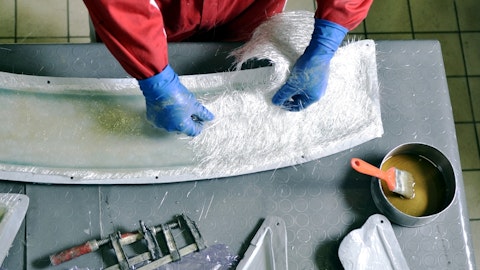John Zimmer: Yes, Tim, one of the things that we keep running up against is the Build America, Buy America challenge with the Infrastructure bill. There’s a requirement that stuff is built in America, United States. We do have one of our processes that we do not currently do in the United States. So we are actively looking about how do we get that process in the United States. Would it be better to acquire into it or to try to buy some presses and get them up and running? So we’re definitely looking at how do we take advantage of the Build America, Buy America, all our other processes we do in the United States for the most part. So we’re good there. And then I think we’ll also look at a little bit of our footprint. We still are a company that make large parts, so where you’re located is very important.
And so some of our strategy might be to continue to build up a little bit Southwest and see how we can maybe get across the United States a little bit more with all different processes and have additional locations, maybe more in the Southwest.
Tim Moore: Great. That’s really helpful granularity and color. Yes, no, I wish you luck with the year. I actually think like the other company I cover. Hopefully you’re being conservative on sales guidance and you get to the fourth quarter lapping things, these stocking could be done and maybe some normalization. So you could have maybe a decent second half of the year on the top line, at least. So thanks a lot. Appreciate it.
John Zimmer: Thanks, Tim.
Dave Duvall: Thanks.
Operator: Thank you very much. [Operator Instructions] The next question comes from Bill Dezellem with Tieton Capital. Please go ahead.
Bill Dezellem: Thank you. Would you please discuss the building products revenue decline from 5 million last year Q4 down to 2 million or so this year?
Dave Duvall: Yes. It was quite an abrupt change for us. We were actually had several programs that were getting ready to launch, and we were already supplying product. And a lot of the customers were basically saying, we’ll take everything that you can build. And when we did that, I think they have a lot of areas to store inventories, whether that’s in their warehouses or at job sites. So you’ll see a lot of the large stormwater drains, vaults, lids, things like that that are already outside. They store them outside. And I think when they started seeing some of the volume decline, they looked at their inventories and reevaluated their inventories and really put a slowdown on consuming that inventory near year end and into the beginning of this year. We’ve talked with really every customer as far as when they expect the demand to come back. Right now they’re telling us sometime near the end of Q1.
John Zimmer: And, Bill, I think maybe you mentioned building products kind of in that concept, so our building product is primarily one customer.
Bill Dezellem: Yes, I was talking industrial utilities.
John Zimmer: Yes. And so I think you kind of said building products, which kind of Dave did a good explanation on that one. On building products we deal with one customer that does big box retail. And so we’re a little bit subject to the programs they have at the big box retailers. And again, we produce their lattice, so we have all their lattice and it really is their structure, their sales throughput with the big box retailers and how many stores they have and those types of things and so at this point I think there’s been a little bit of a slowdown in that area and not totally clear, but I’m sure the person we sell to has different situations going on with the building or with the big box and what they’re selling and those types of things.
But we’re still selling lattice to that customer the Universal Forest Products and still have a real good relationship with them. And so we really count on them to drive the sales, they drive the sales into the big box. We produce the parts for them.
Bill Dezellem: Okay, just to be clear then, that it was your utility business that saw the slowdown, really that abrupt decline as they reviewed their inventory. And then Universal Forest Products was the one that had the slowdown basically as a result of the Home Depot Lowes’ seeing their sales slow. Did I interpret kind of those pieces correctly?
John Zimmer: Yes. That’s correct, yes.
Bill Dezellem: Okay, excellent. And that just to be clear, that would be under the industrial and utilities category, the first answer. Not in the all other category, which saw a pretty big decline from Q3, is that correct?
John Zimmer: Yes. The specific inventory adjustment was industrial and utilities.
Bill Dezellem: Okay, excellent. That’s helpful. And then I am going to just jump back to the all other category where revenues declined from Q3 at $12.5 million or so, and then went to Q4 more like $5 million, $6 million. That was also a pretty abrupt decline. Would you walk through that phenomenon also for us, please?
John Zimmer: Yes. I mean, really what we see usually in the Q4 time period is the all other will be from seasonality standpoint. When you look at Q3 to Q4, we’ll usually have a normal slowdown. A lot of those will be where we’re doing programs for customers that were overflow business on those types of things. And as they slow down in that quarter, they’ll pull back from us. From that standpoint, we see those types of sales coming back slowly over time because we are in the all other, in certain situations, overflow molder. And so as they start to ramp back up in the Q1, Q2 [ph] time period, we’ll start to pick up from that standpoint and pick up some of their business back up.
Bill Dezellem: That’s really helpful, John, and what are the products that see that seasonality?
John Zimmer: So some customers, like a customer, what we disclose is ORBIS, they’ll do packaging for the auto industry and during that time period, and when I say packaging, returnable packaging, big crates that are returnable packaging and used in the industrial market, those types of things, those will be where they mold some themselves, but they also outsource to us some of their molding. And again, during Q4 is usually a very slow time period for them anyways. And so at any given time we’ll have tools going back and forth between us and them and they’ll send us over tools and ramp up for a quarter or two and then kind of take a tool back and then give us some additional tools. And so stuff like that where Q4, by nature in those industries are just slow.


